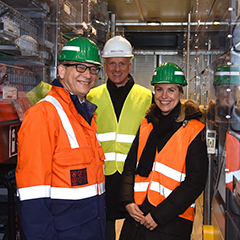- Over 550 lithium-ion battery modules installed; battery modules are of the same type as those used in hybrid vehicles
- Nominal output corresponds to the battery capacity of 700,000 smartphones
- Battery storage provides primary frequency control power for the electricity grid
Herdecke, Germany – A new energy storage facility officially began operating today on the grounds of the RWE pump storage power plant in Herdecke, Germany. The battery storage facility has a rated capacity of roughly 7 MWh, which corresponds to the battery capacity of 700,000 smartphones. BELECTRIC built and commissioned the facility as the general contractor for RWE. The total investment volume is roughly €6 million.
“Our battery storage systems make an important contribution to the successful realisation of the energy transition. This is because storage technologies are the link between modern grids and unpredictable production using renewable energies,” explains Frank Amend, who is the managing director responsible for BELECTRIC’s storage and hybrid business.
The new battery storage facility in Herdecke consists of three 40-foot containers. Each of these containers has been equipped with 184 lithium-ion battery modules of the same type as those used in hybrid vehicles. BELECTRIC designed and constructed the storage system on the basis of these powerful battery modules. The capacity of all the modules is accessed and steered centrally using a communications infrastructure developed by BELECTRIC.
“Figuratively speaking, it is like accelerating and braking over 550 ‘vehicles’ in sync without allowing the batteries to run out of power. And this has to be kept going 24 hours a day, 7 days a week,” explains Frank Amend.
Large storage systems like the facility in Herdecke provide grid services, such as primary control power. This means they respond to frequency changes and store electricity from the grid or feed energy into the grid as needed. As a result, they help not only to even out the fluctuating feed-in from renewable energies, but also to efficiently stabilise the grid and guarantee a reliable electricity supply.
BELECTRIC realises battery storage facility for RWE in Herdecke



























